Physical Address
304 North Cardinal St.
Dorchester Center, MA 02124
Tumors that spread to the ovary have been referred to as secondary (those spreading directly from adjacent sites) or metastatic (those spreading from distant sites), but all tumors that spread from outside the ovary are referred to here as metastatic.
Metastases to the ovary account for about 5% of ovarian cancers found at laparotomy. Patients with the most common metastatic cancers in the ovary (intestinal, appendiceal, gastric, mammary) tend to be younger than those without ovarian spread. The greater vascularity of the ovary in younger women likely facilitates hematogenous spread.
Tumors spread to the ovary by blood vessels and lymphatics, transperitoneally (gastric and pancreaticobiliary tumors in particular), by direct extension (tumors of the tube and uterus, mesotheliomas, occasional colonic and appendiceal carcinomas), and via the tubal lumen (genital tract carcinomas).
Gross and/or microscopic features that should suggest a metastatic tumor:
Bilaterality. As metastases are bilateral in 40–70% of cases, the possibility of metastasis increases with bilateral cancers, particular when <10 cm. However, ovarian metastases that are the first manifestation of an extraovarian primary are often >10 cm ( ).
Surface implants, often with a desmoplastic stroma.
Multiple discrete ovarian nodules and in some such cases variation in appearance from one nodule to another (e.g. benign-appearing glands and cysts in one nodule and obviously malignant glands within a reactive stroma in an adjacent nodule).
A morphology unusual for primary ovarian neoplasia (e.g. colloid carcinoma) or if mucinous or endometrioid-like. However, in contrast to some investigators, we have not found that metastatic mucinous carcinomas are more common than primary mucinous carcinomas.
Lymphatic or blood vessel invasion and/or invasion of normal follicular structures.
Potentially misleading features that may incorrectly suggest a primary vs a metastatic tumor:
Evidence of hormonal function. Metastatic tumors to the ovary commonly elicit stromal luteinization that can result in hormonal manifestations. These ‘tumors with functioning stroma’ are considered at the end of this chapter.
A large ovarian tumor with no apparent extraovarian primary tumor. Large metastatic tumors in the ovary may dwarf a small primary tumor, e.g. large bilateral Krukenberg tumors due to a tiny occult gastric primary. The primary tumor may only be discovered after removal of the ovarian metastasis or at autopsy.
A cystic gross appearance. Ovarian metastases may be predominantly cystic (or less commonly purely cystic), even when the primary tumor is solid, and thus may be grossly indistinguishable from a primary cystic tumor.
Histologically benign appearing foci. Metastatic carcinomas in the ovary, particularly those of mucinous type, may contain large areas that appear borderline or even benign (‘maturation phenomenon’) that may mimic primary neoplasms.
Tubules and follicle-like spaces. These are found in many types of metastatic tumor simulating patterns in a variety of primary ovarian neoplasms, particularly sex cord–stromal tumors.
Recognition of an ovarian tumor as metastatic depends to a varying extent on an adequate clinical history, astute intraoperative pathologic evaluation, operative or postoperative search for an extraovarian primary, careful evaluation of the gross and microscopic features of the ovarian tumor (including its comparison with any previous extraovarian tumors), and in some cases, immunohistochemical stains.
Removal of a metastatic tumor in an ovary can be rarely associated with prolonged survival, suggesting isolated spread in such cases.
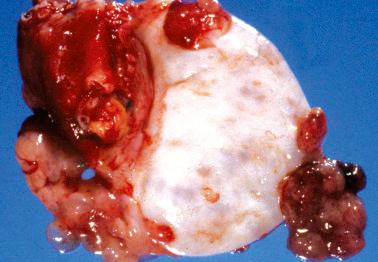
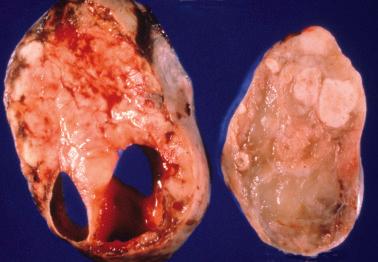
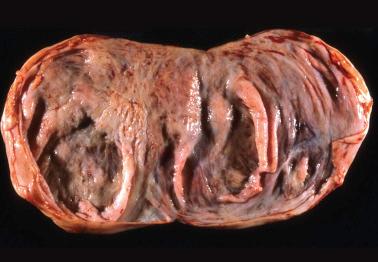
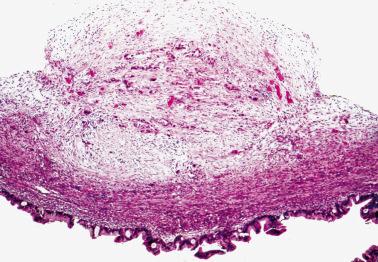
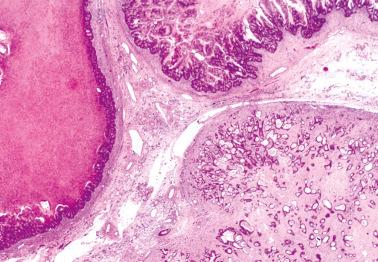
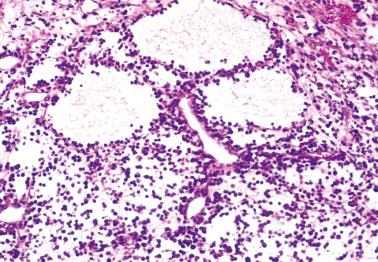
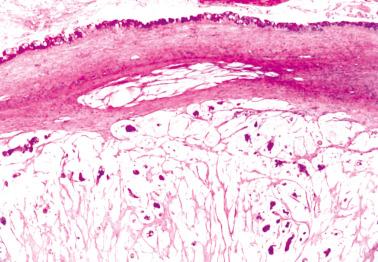
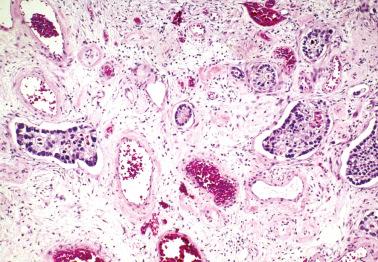
Consideration of features helpful on permanent section evaluation are applicable, but limited sampling introduces an inherent error rate.
Unilateral and sizeable tumors (defined in one study as ≥13 cm) are much more likely to be primary than bilateral tumors that are <10 cm; this algorithm correctly classified 87% of mucinous carcinomas as primary or metastatic in one study. However, as exceptions occur these findings should be used only as an adjunct to complete clinicopathologic evaluation.
The external surface should be carefully inspected for implants; application of colored ink to any suspected implants can aid their microscopic recognition as serosal (vs intracystic). Any ruptured locules should be identified so that they can be separately sampled after fixation.
The adjacent adnexal tissue should be evaluated for separate nodules that may heighten the likelihood of the ovarian tumor being metastatic if a putative primary tumor (e.g. carcinoid) would not be expected to show extraovarian spread.
The vast majority of ovarian metastases of gastric origin are Krukenberg tumors due to the great propensity for ovarian spread of gastric cancers with signet-ring cells. Tumors of other organs with a signet-ring component have the same tendency.
Krukenberg tumor is defined as a metastatic carcinoma with a component of signet-ring cells accounting for at least 10% of the tumor. Small microcystic glands with flattened lining cells and larger typical intestinal-type glands are often present, as are, less commonly, mucinous glands. A variably prominent fibrous stroma is common, usually being edematous but sometimes mucoid or intensely cellular.
Over 70% of Krukenberg tumors arise in the stomach, usually the pylorus. Most other examples originate in the appendix, colon, gallbladder, biliary tract, and breast. Rare origins include pancreas, urinary bladder, uterine cervix, and renal pelvis.
Krukenberg tumors are the commonest ovarian metastatic carcinoma in young adults (average age, ~45 years). Almost 90% of patients have symptoms related to ovarian involvement (abdominal pain and swelling). Other occasional symptoms include abnormal uterine bleeding, androgenic manifestations due to stromal luteinization (particularly during pregnancy), and those related to extraovarian sites of spread.
The gastric carcinoma is usually diagnosed preoperatively, at oophorectomy, or within a few months thereafter, but a small primary may remain occult for 5 or more years after oophorectomy. Very small primaries, particularly of stomach or breast, may require exhaustive sectioning to detect them, even at autopsy.
Sometimes massive abdominal disease precludes determining a primary site with certainty, a possible appendiceal origin, in particular, often being obscured.
Almost all patients die within a year of the diagnosis, but there have been rare long-term survivors with no clinical evidence of tumor after bilateral oophorectomy and removal of the primary neoplasm.
Gross examination reveals bilateral tumors (in ~80% of cases) that are usually bosselated, sometimes cerebriform, solid masses.
The sectioned surfaces are white to tan to pale yellow, often with foci that are purple, red or brown, and firm, fleshy, gelatinous, or spongy. A softer consistency is sometimes present centrally with a peripheral thin rim of different consistency and color.
Some tumors are uniformly solid and firm and may grossly simulate a fibroma, or if edematous, an edematous fibroma. Occasionally, large, thin-walled cysts contain mucinous or watery fluid. Some tumors exhibit extensive hemorrhage and necrosis.
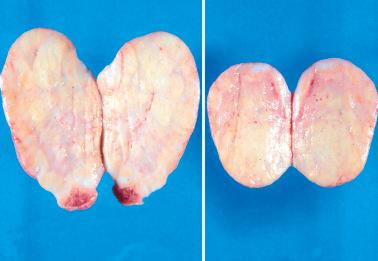

A common low-power appearance is cellular lobules separated by less cellular often edematous to focally mucoid stroma. Another common low-power appearance is a more compact growth peripherally with edema centrally, with tumor cells ramifying into the latter.
The mucin-rich signet-ring cells occur singly, as small clusters, or as large, sometimes smoothly contoured, round to oval to elongated nests that may appear pseudotubular.
The cytoplasm of the signet-ring cells is usually pale and vacuolated but may be basophilic or eosinophilic or contain a clear vacuole containing a central eosinophilic body. Mucin in the signet-ring cells is usually easily demonstrable by PASD or other mucin stains.
Some tumor cells have an indifferent mucin-negative appearance and may be small and deceptively benign in appearance. Rare findings include cells with abundant clear mucin-negative cytoplasm or squamous or transitional-type cells.
The stroma is often edematous but may resemble a typical fibroma or less often a cellular fibroma. Mucin pools may be conspicuous. Luteinized stromal cells are often present, particularly in pregnant patients.
Other frequent findings include small glands, often with flattened lining cells imparting a microcystic pattern; a prominent hollow or solid tubular architecture; typical intestinal-type glands lined by stratified epithelium; large endometrioid-like glands; cysts lined by mucinous or flattened nonspecific epithelium that may be minimally atypical; abundant collagen intersecting mucin (‘feathery degeneration’); marked stromal edema; and blood vessel and lymphatic invasion.
Krukenberg tumors of appendiceal origin can exhibit distinctive features including patterns reminiscent of goblet cell carcinoids (‘appendiceal-type crypt cell adenocarcinomas’) (Hristov et al., Reid et al.). In these cases, goblet cells may form acini, microglandular patterns, nests, cords, or are singly disposed.
Krukenberg tumors of colonic and biliary origin are microscopically indistinguishable from those of gastric origin and those of appendiceal origin but without the distinctive features noted above. Those from other sites, such as breast, lack the frequent intestinal-type glands of those of gastrointestinal and biliary origin.
Immunohistochemistry may help localize the primary site: CDX2+/CK7+/MUC1+/HepPar 1+/ER−/SATB2− profile favors stomach; SATB2+/CDX2+/MUC2+/ MUC1−/HepPar 1−/ER− favors colon (including appendix); MUC1+/CK7+/ER+/GATA3+/mammaglobin+/GCDFP-15+ favors breast.
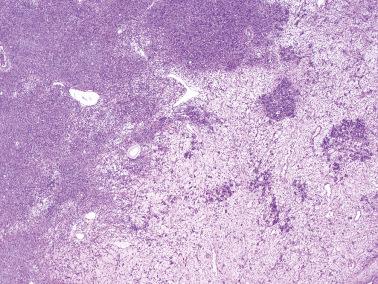
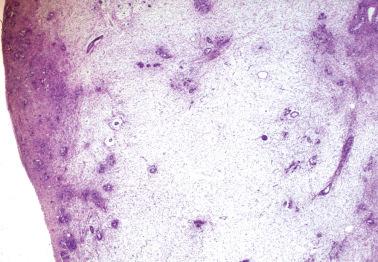
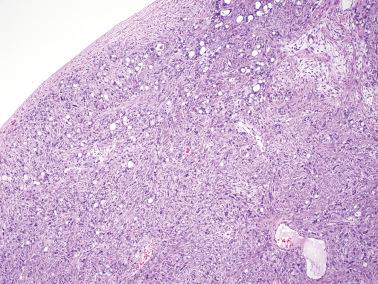
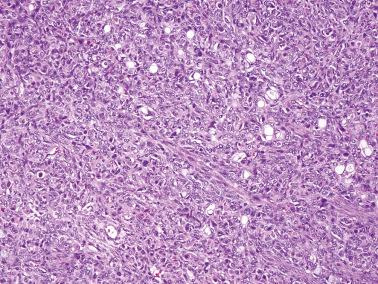
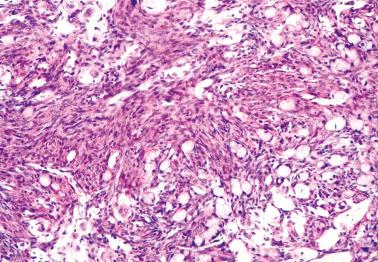
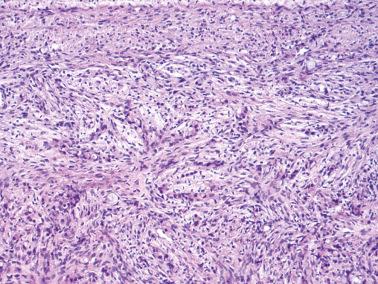
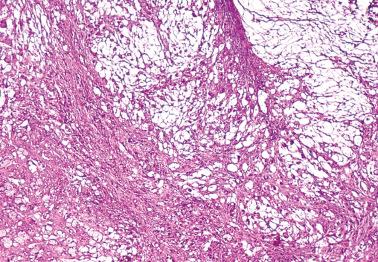
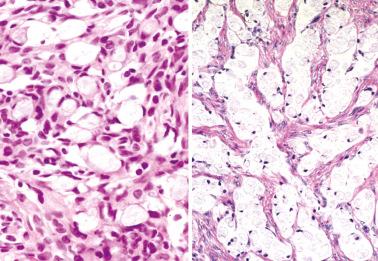
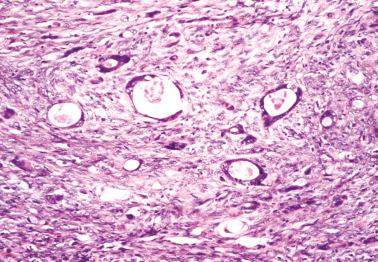
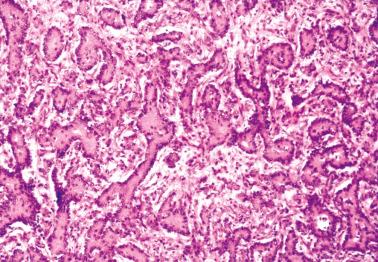
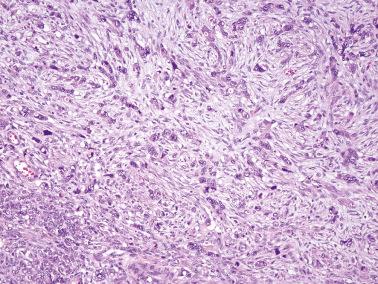
Almost all the tumors considered below are unilateral in contrast to Krukenberg tumors and the non-neoplastic lesions are not usually grossly evident. Additionally, there are a variety of microscopic differences between Krukenberg tumors and the various entities considered; only the more important are highlighted.
Sertoli–Leydig cell tumor (SLCT). A SLCT may be suggested by cellular lobules (as in SLCTs of intermediate differentiation), tubules, and luteinized stromal cells (mimicking Leydig cells). However, SLCTs (except heterologous tumors containing mucinous carcinoid) lack signet-ring cells and exhibit typical patterns of SLCT.
Clear cell carcinomas (CCCs). CCCs may have signet-ring cells and Krukenberg tumors may have microcysts somewhat similar to those in CCCs. However, other characteristic patterns of CCC, such as papillary, are almost always present and the overall constellation of patterns and cell types is definitive. CCC is often associated with endometriosis.
Mucinous carcinoid tumors with signet-ring cells. These rare tumors are usually better differentiated both architecturally and cytologically than a Krukenberg tumor, are infrequently bilateral, and may be associated with a dermoid, or rarely an epidermoid, cyst. It should be noted that Krukenberg tumors can also contain neuroendocrine cells. A poorly differentiated mucinous carcinoid likely accounts for at least some examples of so-called primary Krukenberg tumor.
Fibroma. The presence of typical signet-ring cells excludes this diagnosis (caveat: fibromas rarely may contain mucin-negative signet-ring-like cells).
Sclerosing stromal tumor. Signet-ring cells in this tumor contain lipid not mucin.
Signet-ring stromal tumor. The vacuolated cells in this tumor are mucin-negative.
Mucicarminophilic histiocytosis ( Chapter 12 ). The lesional cells are PAS-negative.
Adenomatoid tumor. Ovarian adenomatoid tumors are very rare and have their own distinctive features ( Chapter 17 ), including the presence of mesothelial but not epithelial markers.
Ovarian cortical inclusions with a vacuolar, mucin-negative, presumably hydropic cytoplasmic change ( Chapter 12 ).
A listing of ovarian lesions that may contain signet-ring cells is presented in Table 18.1 .
| METASTATIC TUMORS |
|
| PRIMARY TUMORS |
|
| TUMOR-LIKE LESIONS |
|
a Benign signet-ring-like stromal cells are rarely encountered in the fibrous stroma of serous cystadenofibromas (see Chapter 13 , Benign Serous Tumors).
Ovarian metastases of these tumors, which are rare, present at a slightly older age than patients with Krukenberg tumors and are usually found after removal of the gastric primary.
The tumors are typically unilateral. The sectioned surface usually resembles that of metastatic intestinal adenocarcinoma rather than a Krukenberg tumor.
Most tumors are composed of small to large glands that often have a pseudoendometrioid appearance. Occasional glands may be lined by columnar cells with pale cytoplasm or with an indifferent appearance. Signet-ring cells are usually absent, or if present, definitionally account for <10% of the tumor.
‘Dirty’ necrosis is common. The stroma usually lacks the edematous or mucoid appearance of many Krukenberg tumors.
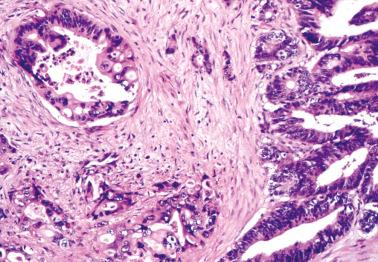
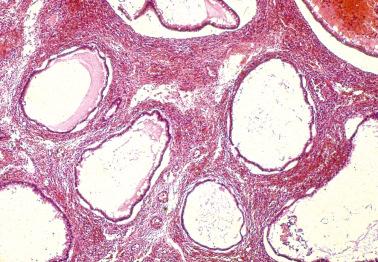
These tumors are distinguished from pseudoendometrioid metastases of other origins by clinical findings and from Krukenberg tumors with a glandular component by the absence or rarity of signet-ring cells.
Ovarian metastases occur in ~5% of women with colorectal cancer. Almost all patients die within 3 years of detection of ovarian involvement. These ovarian tumors may be misinterpreted clinically or microscopically as primary ovarian tumors, even when there is a known colon cancer.
Judson et al. found that women with ovarian metastases whose colorectal carcinomas were found at oophorectomy (vs those with a history of a colorectal carcinoma) were younger (mean, 48 vs 61 years), more often had elevated CA125 levels, more often presented with clinical findings related to the ovarian tumor(s), and lacked bowel symptoms.
Seventy-five percent of women have a known intestinal carcinoma that in 90% of cases antedated the ovarian tumor by <3 years; 20% have unexpected ovarian involvement found during resection of a colonic carcinoma; and 5% present with an ovarian tumor, postoperative work-up usually disclosing the intestinal primary.
The site of the primary tumors in one study was 77% in the rectosigmoid, 9% ascending colon, 9% cecum, 5% descending colon, and rarely the transverse colon. Mitsushita et al., in a recent literature review, found 72 cases of ovarian metastases from the small bowel.
Metastatic colonic carcinomas are among the most common ovarian tumors, excluding those in the sex cord–stromal category, that are associated with estrogenic or androgenic manifestations as a result of functioning stroma.
The ovarian tumors, which are bilateral in ~60% of cases, may form nonspecific solid masses, but are more often solid and cystic, sometimes being predominantly cystic. They are frequently large and may rupture preoperatively or during their removal.
Sectioning typically reveals friable or mushy yellow, red, or gray tissue and cysts with necrotic, mucinous, clear, or bloody contents. Multiple thin-walled cysts with mucinous contents may rarely simulate a mucinous cystic neoplasm.
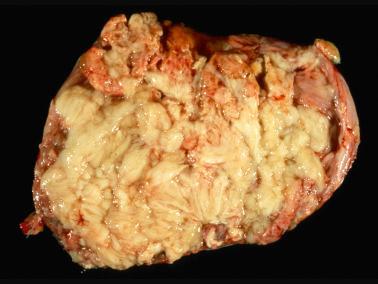
On low power the ovarian parenchyma is usually effaced but in smaller tumors it may separate nodules of tumor that often have a prominent desmoplastic stroma.
The tumors usually have a strong resemblance to typical colonic adenocarcinomas.
Characteristic features include small or large glands often in a cribriform pattern, extensive ‘dirty’ necrosis (eosinophilic material with nuclear debris within cyst and gland lumens), a garland appearance (glands in a ring at the edge of the necrotic material), and focal segmental necrosis of the glandular epithelium .
The glands are typically lined by stratified cells with moderate to severe cytologic atypia and frequent mitotic figures. Mucin-containing goblet cells may be scattered among mucin-free cells, but are often absent. Cysts lined by well-differentiated mucin-rich or flattened nonspecific epithelium are present in occasional cases.
Occasionally the appearance is that of a colloid carcinoma, or, when the primary intestinal tumor (sometimes small intestinal) is of the rare clear cell type, an endometrioid carcinoma of secretory type or clear cell carcinoma is simulated. An occasional papillary pattern may focally mimic a serous carcinoma.
The stroma may be desmoplastic, edematous, or mucoid, and contains luteinized cells in 30% of cases. Lymphovascular space invasion is common.
The typical CDX2+/SATB2+/CK20+/PAX8−/CK7−/ER−immunoprofile contrasts with those of most primary epithelial tumors in the differential (particularly endometrioid and mucinous carcinomas) ( Table 18.2 ), some of which may also exhibit dirty necrosis. Exceptions include occasional CK7+ colonic metastases (most commonly of rectal or appendiceal origin), SATB2+ teratoma-associated mucinous tumors ( Chapter 13 ), and occasional CDX2+ endometrioid carcinomas (morules being usually CDX2+).
| Cytokeratins [1] | CDX2 [2–4] | SATB2 [5,6] | |
|---|---|---|---|
| FEMALE GENITAL TRACT | |||
| Primary ovarian mucinous carcinomas | CK7+/CK20+ (56%), CK7+/CK20− (44%) | CDX2+ (36%) | 0% |
| Metastatic endocervical carcinomas | CK7+/CK20+ (88%), CK7+/CK20− (13%) | Expected in some a | |
| GASTRIC/PANCREATICOBILIARY TRACT | |||
| Metastatic pancreatic carcinoma | CK7+/CK20+ (79%), CK7+/CK20− (21%) | CDX2+ (64% b ) | 0% c |
| Metastatic gastric carcinoma | CK7+/CK20+ (80%), CK7−/CK20+ (20%) | CDX2+ (100%) | 0% c |
| Metastatic gallbladder/biliary carcinoma | CK7+/CK20+ (75%), CK7−/CK20+ (25%) | CDX2+ (64% b ) | 0% c |
| LOWER INTESTINAL TRACT | |||
| Metastatic colorectal carcinomas | CK7−/CK20+ (82%); CK7+/CK20+ (11%) | CDX2+ (88–100%) | 75% |
| Metastatic appendiceal carcinoma | CK7−/CK20+ (65%); CK7+/CK20+ (35%) | CDX2+ (100%) | 100% |
| Metastatic appendiceal low-grade tumors | CK7−/CK20+ (87%); CK7+/CK20+ (13%) | CDX2+ (100%) | 80–94% |
a CDX2 immunoreactivity was found in almost 40% of primary endocervical adenocarcinomas by Saad et al. (Am J Clin Pathol 2009;132:531–538) and thus would be expected in at least some of their ovarian metastases.
b Included pancreatic and biliary tract carcinomas.
c These staining results (Moh et al., Am J Surg Pathol 2016;40:419-432) are based on findings in the primary gastric and pancreaticobiliary tract tumors.
1 Vang R, Gown AM, Barry TS, et al. Cytokeratins 7 and 20 in primary and secondary mucinous tumors of the ovary: Analysis of coordinate immunohistochemical expression profiles and staining distribution in 179 cases. Am J Surg Pathol 2006;30:1130–1139.
2 Vang R, Gown AM, Wu L, et al. Immunohistochemical expression of CDX2 in primary ovarian mucinous tumors and metastatic mucinous carcinomas involving the ovary: comparison with CK20 and correlation with coordinate expression of CK7. Mod Pathol 2006;19:1421-1428.
3 Nonaka D, Kusamura S, Baratti D, et al. CDX-2 expression in pseudomyxoma peritonei: a clinicopathologic analysis of 42 cases. Histopathology 2006;49:381–387.
4 Groisman GM, Meir A, Sabo E. The value of Cdx2 immunostaining in differentiating primary ovarian carcinomas from colonic carcinomas metastatic to the ovaries. Int J Gynecol Pathol 2004;23:52–57.
5 Moh M, Krings G, Ates D, et al. SATB2 expression distinguishes ovarian metastases of colorectal and appendiceal origin from primary ovarian tumors of mucinous or endometrioid type. Am J Surg Pathol 2016;40:419–432.
6 Strickland S, Parra-Herran C. Immunohistochemical characterization of appendiceal mucinous neoplasms and the value of SATB2 in their distinction from primary ovarian mucinous tumors. Histopathology 2016;68:977-987.
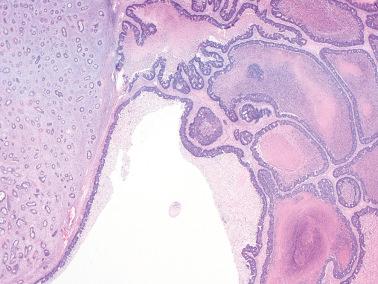
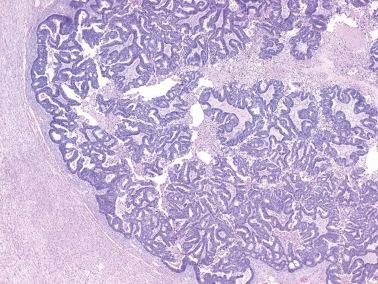
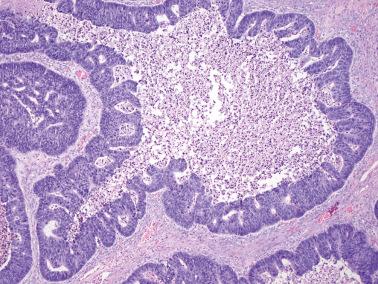

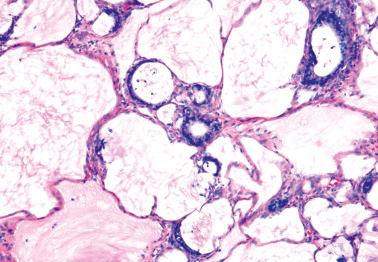
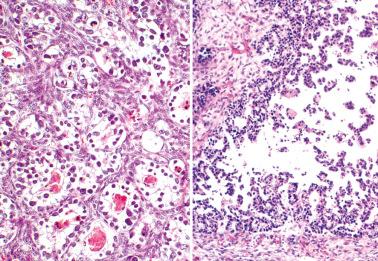
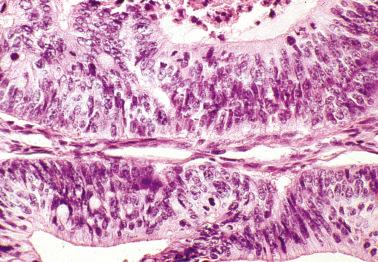
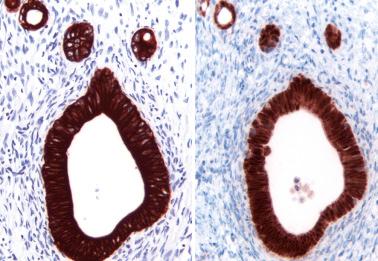
Primary endometrioid adenocarcinoma. Features favoring or establishing a diagnosis of metastatic colonic carcinoma include:
A known primary intestinal cancer, bilaterality, multiple nodules, dirty necrosis (particularly when extensive and associated with one or more of the other features listed here), segmental necrosis, and higher-grade nuclei and mitotic activity than in endometrioid carcinomas with similar degrees of glandular differentiation.
An absence of metaplastic squamous epithelium, adenofibromatous areas, and associated endometriosis.
The immunoprofile noted above (and Table 18.2 ). Endometrioid carcinomas are typically CK7+/PAX8+/CK20−/CDX2−/SATB2− with exceptions noted above.
Primary mucinous adenocarcinomas.
These tumors have a much lower frequency than metastatic intestinal cancer of the following: bilaterality, multinodularity, dirty necrosis, vascular-space invasion, and surface involvement. An origin of some tumors from a dermoid cyst also indicates a primary tumor.
Small areas of carcinoma with a background of an extensive benign or borderline mucinous tumor strongly favor a primary carcinoma. However, metastatic intestinal carcinomas may focally have a deceptive appearance that may simulate a benign or borderline mucinous tumor.
Immunostains are helpful ( Table 18.2 ). The vast majority of metastatic colorectal carcinomas and appendiceal carcinomas involving the ovary are SATB2+ whereas primary ovarian mucinous or endometrioid carcinomas are SATB2− (Moh et al., Strickland and Para-Herran). PAX8 is present in 65% of primary mucinous carcinomas but in <2% of intestinal carcinomas.
CCC and secretory endometrioid carcinoma vs metastatic colonic carcinoma of clear cell type. The presence of bilaterality, prominent dirty necrosis, and the immunoprofile noted above all favor or establish the latter diagnosis.
Low-grade appendiceal mucinous neoplasms (LAMNs) are the commonest appendiceal tumor that spread to the ovary (Misdraji et al.). The ovarian spread is usually associated with pseudomyxoma peritonei (see Chapter 20 ).
The ovarian tumors are often large, multicystic, and bilateral. The cysts often contain jelly-like mucin, occasional ovarian tumors appearing as ‘bags of jelly’. The appendix may exhibit a mucocele or exhibit no gross abnormality; sometimes only the presence of appendiceal serosal mucin indicates an appendiceal lesion.
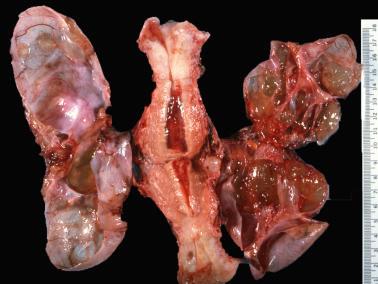
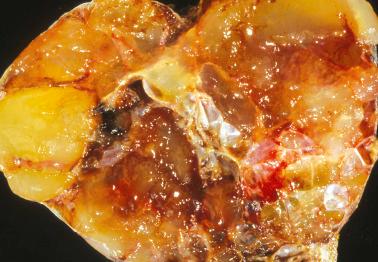
Metastatic LAMNs to the ovary are typically accompanied by mucin on the ovarian surfaces and within the ovary, often with a dissecting growth pattern (pseudomyxoma ovarii). Mucinous epithelial cells are usually, but not invariably, present within the ovarian and extraovarian mucin. Characteristic histologic findings within the ovarian metastases include:
Glands and cysts, often with multiple shallow outpouchings resulting in a scalloped contour, are lined by highly differentiated, tall, mucin-rich (‘hypermucinous’) cells, often with mucin exuding from their apices.
found that retraction of the mucinous epithelium from the stroma, resulting in a cleft-like space, is present in almost all cases, in contrast to the rarity of this finding in primary nonteratoma-associated ovarian intestinal mucinous borderline tumors (IMBTs). Conversely, reactive stroma and histiocytic aggregates are rare in metastatic LAMN in contrast to their common presence in IMBTs.
A caveat is that the characteristic features of LAMN metastatic to the ovary can also be seen in teratoma-associated mucinous neoplasms ( Chapter 13 ).
The appendiceal tumors other than LAMN are low-grade mucinous adenocarcinomas. These tumors exhibit a more irregular destructive growth and their glandular component varies from large cysts to small sometimes closely packed glands. There is greater atypia than in LAMNs but sometimes this may be appreciated only focally.
The immunohistochemical features are indicated in Table 18.2 . SATB2 has been found in 94% of LAMNs but in only 2.5% of IMBTs (Strickland and Parra-Herran). Li et al. found that a SATB2+/CK20+ immunoprofile showed an 80% sensitivity and 100% specificity in the diagnosis of LAMN vs primary ovarian mucinous tumor.
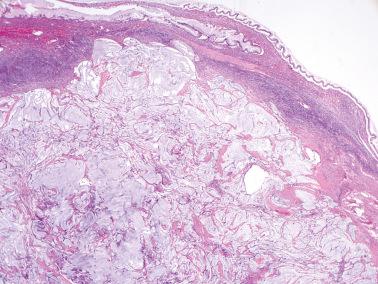
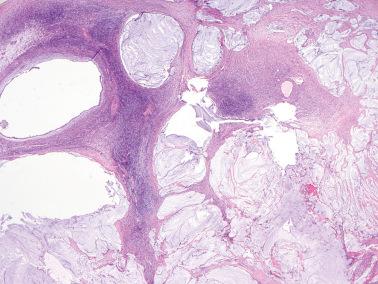
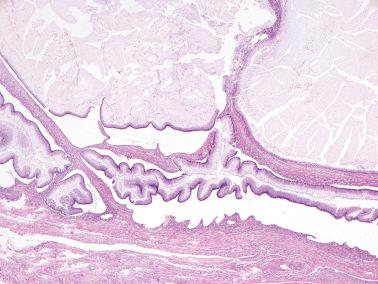
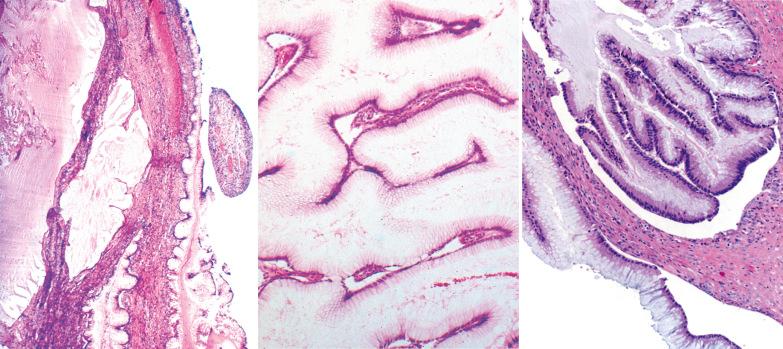
The differential in cases of ovarian involvement by LAMN is with a primary mucinous cystadenoma or intestinal-type borderline tumor.
An association with a dermoid cyst favors an ovarian primary; bilaterality, pseudomyxoma peritonei and ovarii, scalloped glands, subepithelial clefting, and SATB2 positivity suggest or indicate metastatic LAMN. A reactive stroma, histiocytic aggregates, and PAX8 staining favor a primary mucinous borderline tumor.
Gui et al., in a study of 11 cases of synchronous ovarian/appendiceal mucinous neoplasms without pseudomyxoma peritonei (PMP, see Chapter 20 ), found that the presence of ovarian/peritoneal surface mucin, even if microscopic and acellular, was predicative of the subsequent development of PMP. Such tumors also had immunoprofiles with a high concordance between the ovarian and appendiceal tumors.
In cases of low-grade carcinoma, the differential is with other metastatic mucinous adenocarcinomas and primary mucinous carcinoma. Pseudomyxoma peritonei strongly favors an appendiceal origin. Bilaterality and high-stage disease favor metastases. PAX8 and CK7 positivity favor a primary mucinous carcinoma, but negative staining for these markers does not exclude the diagnosis.
See Chapter 20 .
Appendiceal adenocarcinomas that metastasize to the ovaries include those of typical intestinal-type, intermediate to high-grade mucinous carcinomas, colloid carcinomas, and signet-ring cell carcinomas NOS, and so-called appendiceal-type crypt cell adenocarcinomas (Reid et al.).
Kiyokawa et al. found that the appendix was the second most common origin of a Krukenberg tumor. Some such tumors may focally resemble mucinous carcinoid but have other foci that exclude carcinoid. In about one-third of them, the ovarian involvement accounts for the presenting manifestation.
Sirintrapun et al. found that the presence of floating signet-ring cells confined to mucin pools did not affect the prognosis in high-grade appendiceal mucinous carcinoma involving the peritoneum, whereas the finding of signet-ring cells invading tissue was associated with a worse survival.
Although the literature might suggest otherwise, typical carcinoids and mucinous carcinoids rarely spread to the ovaries (see section on neuroendocrine tumors).
Most appendiceal tumors with goblet cell carcinoid-like patterns that spread to the ovary have an appreciable signet-ring cell component and are best classified as adenocarcinomas with neuroendocrine differentiation (Hristov et al.) or appendiceal-type crypt cell adenocarcinomas (Reid et al.). When a primary tumor is not evident, the presence of these ‘goblet cell carcinoid-like’ patterns within an ovarian tumor should suggest an appendiceal primary tumor.
Ovarian involvement by appendiceal intestinal-type adenocarcinomas and signet-ring cell adenocarcinomas has a gross appearance similar to those of metastatic intestinal adenocarcinoma and Krukenberg tumor respectively.
Moderate to high-grade mucinous adenocarcinomas may have nonspecific gross features or in some cases have a gelatinous consistency.
Intestinal-type adenocarcinomas have the typical pseudoendometrioid morphology of colorectal metastases.
Signet-ring cell tumors have the spectrum of Krukenberg tumors, including its tubular variant.
Goblet cell carcinoid-like features may be present in addition to the signet-ring cells. Neuroendocrine cells may be identified immunohistochemically in a minority of cases.
A signet-ring carcinoma with a CK20+/CEA+/CDX2+/CK7− immunoprofile is more likely to be of appendiceal than gastric origin.
Studying high-grade appendiceal mucinous carcinomas with signet-ring cells involving the peritoneum, Sirintrapun et al. found that tumors with signet-ring cells floating in extracellular mucin had a prognosis similar to that of tumors without signet-ring cells whereas those with signet-ring cells invading tissues had a worse survival.
Mucinous carcinomas not of signet-ring-cell-type resemble those originating elsewhere in the intestinal tract, or even more so, the pancreas.
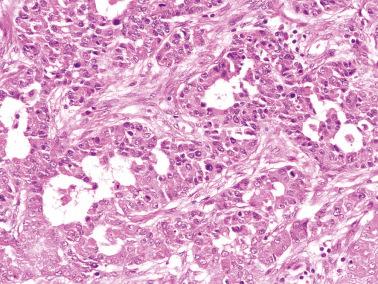
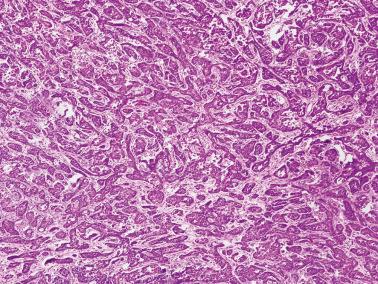
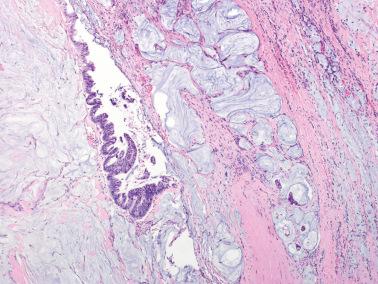
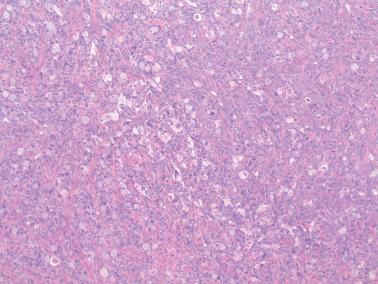
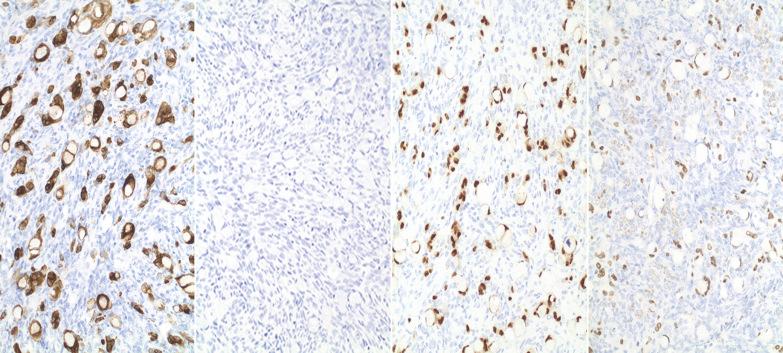
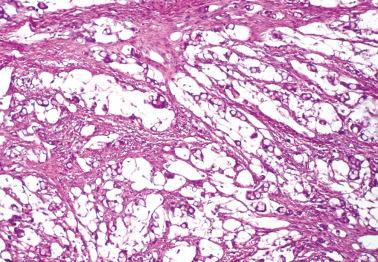
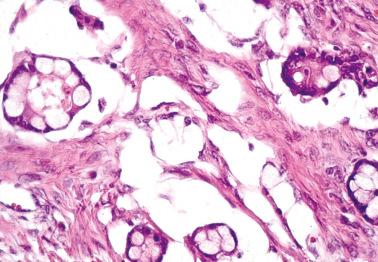
Distinction from morphologically similar metastases originating elsewhere is largely or exclusively dependent on clinical evaluation.
Distinction from primary endometrioid and mucinous carcinoma is as considered under the heading of intestinal carcinomas.
Neuroendocrine tumors metastatic to the ovary, which are mostly well-differentiated, occur over a wide age range (21–82 years; median 57). Most of the primary tumors are small intestinal (usually ileum); less common sites include colon, appendix, stomach, pancreas, and bronchus.
Forty percent of women in whom metastases are found at operation have carcinoid syndrome; some also have signs and symptoms referable to intestinal or ovarian involvement. Extraovarian metastases are also present in at least 90% of the cases.
One-third of patients die within 1 year, and 75% within 5 years. As many as 25% of patients, however, may remain asymptomatic for years postoperatively, with relief of the carcinoid syndrome.
Well-differentiated appendiceal neuroendocrine (carcinoid) tumors of typical type rarely spread to the ovary. ‘Mucinous-goblet cell carcinoids’ have been reported to spread to the ovary with some frequency but most, if not all, of these tumors are, as noted above, best classified as adenocarcinomas (Hristov et al., Reid et al.).
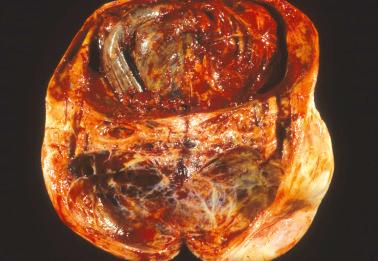
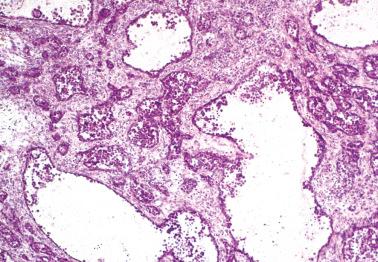
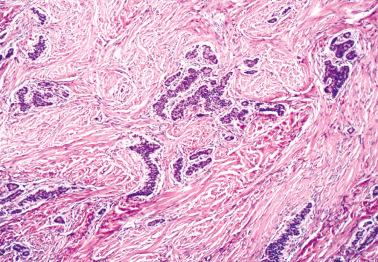

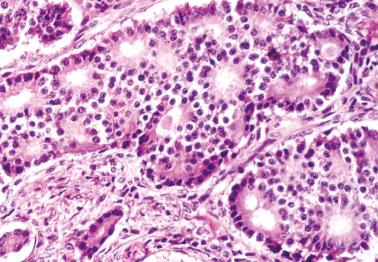
The ovarian tumors, most of which are bilateral, are typically predominantly solid, with smooth or bosselated surfaces. Sectioning reveals single or confluent firm, white or yellow nodules.
Scattered cysts, typically filled with watery fluid, may create an appearance similar to that of a cystadenofibroma; rare tumors are predominantly cystic. Focal necrosis and hemorrhage may occur.
Become a Clinical Tree membership for Full access and enjoy Unlimited articles
If you are a member. Log in here